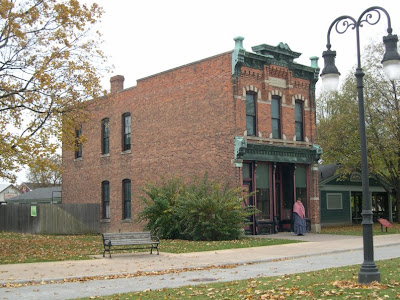Village Blacksmith Shop
 In early American towns the village blacksmith crafted many different products at his forge. Anything made of metal the blacksmith probably made or was handed down from a previous generation or transported at tremendous cost.
In early American towns the village blacksmith crafted many different products at his forge. Anything made of metal the blacksmith probably made or was handed down from a previous generation or transported at tremendous cost.In a small village the blacksmith was
- the hardware store
- the carriage repair shop
- the metal pan repair place
- the place where you had horse's shoes put on
- In some places the blacksmith married couples
 The back of the building
The back of the buildingThe building was erected in the summer of 1929, a copy of a typical blacksmith shop from the 19th century, designed, like the other non-original buildings, by Ed Cutler.
An interesting side is that this building is truly stands in the shade of a spreading chestnut tree, just as written by Henry Wadsworth Longfellow in his 1842 poem, "The Village Blacksmith." This poem, reprinted here in its entirety, describes the sights and sounds of the Village Blacksmith much better than I ever could::
The Village Blacksmith
Under a spreading chestnut-tree
The village smithy stands;
The smith, a mighty man is he,
With large and sinewy hands;
And the muscles of his brawny arms
Are strong as iron bands.
His hair is crisp, and black, and long,
His face is like the tan;
His brow is wet with honest sweat,
He earns whate'er he can,
And looks the whole world in the face,
For he owes not any man.
Week in, week out, from morn till night,
You can hear his bellows blow;
You can hear him swing his heavy sledge,
With measured beat and slow,
Like a sexton ringing the village bell,
When the evening sun is low.
And children coming home from school
Look in at the open door;
They love to see the flaming forge,
And hear the bellows roar,
And catch the burning sparks that fly
Like chaff from a threshing-floor.
He goes on Sunday to the church,
And sits among his boys;
He hears the parson pray and preach,
He hears his daughter's voice,
Singing in the village choir,
And it makes his heart rejoice.
It sounds to him like her mother's voice,
Singing in Paradise!
He needs must think of her once more,
How in the grave she lies;
And with his hard, rough hand he wipes
A tear out of his eyes.
Toiling, -- rejoicing -- sorrowing,
Onward through life he goes;
Each morning sees some task begin,
Each evening sees it close;
Something attempted, something done,
Has earned a night's repose.
Thanks, thanks to thee, my worthy friend,
For the lesson thou hast taught!
Thus at the flaming forge of life
Our fortunes must be wrought;
Thus on its sounding anvil shaped
Each burning deed and thought.
Under a spreading chestnut-tree
The village smithy stands;
The smith, a mighty man is he,
With large and sinewy hands;
And the muscles of his brawny arms
Are strong as iron bands.
His hair is crisp, and black, and long,
His face is like the tan;
His brow is wet with honest sweat,
He earns whate'er he can,
And looks the whole world in the face,
For he owes not any man.
Week in, week out, from morn till night,
You can hear his bellows blow;
You can hear him swing his heavy sledge,
With measured beat and slow,
Like a sexton ringing the village bell,
When the evening sun is low.
And children coming home from school
Look in at the open door;
They love to see the flaming forge,
And hear the bellows roar,
And catch the burning sparks that fly
Like chaff from a threshing-floor.
He goes on Sunday to the church,
And sits among his boys;
He hears the parson pray and preach,
He hears his daughter's voice,
Singing in the village choir,
And it makes his heart rejoice.
It sounds to him like her mother's voice,
Singing in Paradise!
He needs must think of her once more,
How in the grave she lies;
And with his hard, rough hand he wipes
A tear out of his eyes.
Toiling, -- rejoicing -- sorrowing,
Onward through life he goes;
Each morning sees some task begin,
Each evening sees it close;
Something attempted, something done,
Has earned a night's repose.
Thanks, thanks to thee, my worthy friend,
For the lesson thou hast taught!
Thus at the flaming forge of life
Our fortunes must be wrought;
Thus on its sounding anvil shaped
Each burning deed and thought.
Unfortunately, this building is no longer used for blacksmithing. It has become a storage unit, opened here and there (usually during the Christmas season) for displays.One can hope that the powers-that-be will one day bring it back to its former glory.
 This photo is from a souvenir picture card purchased at Greenfield Village around 1971, showing the Village Blacksmith Shop in its heyday
This photo is from a souvenir picture card purchased at Greenfield Village around 1971, showing the Village Blacksmith Shop in its heyday
 This photo is from a souvenir picture card purchased at Greenfield Village around 1971, showing the Village Blacksmith Shop in its heyday
This photo is from a souvenir picture card purchased at Greenfield Village around 1971, showing the Village Blacksmith Shop in its heyday.



Comments